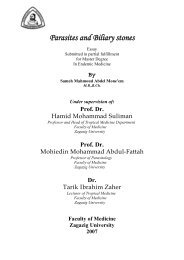E. Coli
E. Coli
E. Coli
Create successful ePaper yourself
Turn your PDF publications into a flip-book with our unique Google optimized e-Paper software.
2.REVIEW OF LITERATURE<br />
2.1. Incidence of pathogenic Enterbacteriaceae.<br />
Review of Literature<br />
2.1.1. Different E. coli serotypes isolated from broilers:<br />
Bozorgmehri et al. (1980) isolated 90 strains of E.coli from<br />
chickens and recorded that the registrated serotypes were O78: K80,<br />
O111:B4, O128:B12, O119:B14 and O86:B7 while the remaining<br />
strains could not be serologically typed.<br />
Burkhanova (1980) isolated 337 strains of enteropathogenic E.<br />
coli from blood, bone marrow and liver of dead baby chicks. He<br />
proved that the prevalent serogroups of E. coli were O:9, O:119, O:55,<br />
O:125, O:26 and O:78.<br />
Abd El-Galil et al. (1983) isolated E.coli from first 10 days old<br />
dead baby chicks of a private poultry farms in Sharkia Government.<br />
They were 30 cases with an incidence of 15% and the most prevalent<br />
pathogenic serogroups were O:125, O:119, O:78 and O:55.<br />
Joya et al. (1990) investigated two outbreaks of diarrhea in<br />
broiler chicks at two independent farms in the Philippines from, which<br />
no pathogens other than E.coli were found.<br />
Osman (1992) examined 150 bacteriological swabs, which were<br />
taken directly from liver, spleen, lung and heart blood of first ten days<br />
old chicks, which were collected from various localities in Sharkia<br />
Governorate broiler farms. Forty two E.coli strains were isolated with<br />
3
















